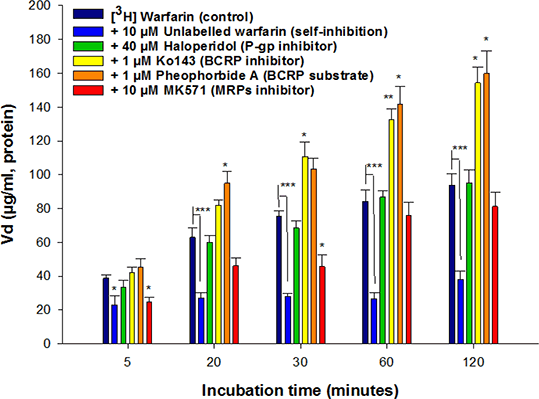| 092P London, UK Pharmacology 2016 |
Transporter interaction of warfarin, a traditional oral vitamin K antagonist with the mouse blood-brain barrier in vitro: evidence for BCRP involvement.
Introduction: Warfarin is a vitamin K antagonist that has been traditionally used for prophylaxis and treatment of thrombosis. An adverse event associated with warfarin treatment is intracranial haemorrhage. To explore the interaction of warfarin with the brain vasculature we investigated the ability of warfarin to interact with transporters expressed at the blood-brain barrier (BBB) by means of a commercially available immortalized adult mouse brain cell line, b.End3 cells.
Method: The accumulation of [3H]warfarin into bEnd.3 cells was investigated at five different time points: 5 min, 20 min, 30 min, 60 min and 120 min. Different transporter inhibitors/ substrates were added to the accumulation buffer and the results compared to [3H]warfarin alone (control). Raw data were corrected for protein content and extracellular space ([14C]sucrose). Results were expressed as the mean (Vd, µg/ml of protein)±SEM, n =4-6 plates, with 6 replicates per plate, passage number 16-24. Comparisons were made between control and test plates of cells at each time point by one-way ANOVA. Differences at p <0.05 were considered significant.
Results: The accumulation of [3H]warfarin (34 nM) was significantly decreased by the presence of unlabelled warfarin (Figure 1). However, ATP depletion experiments did not change accumulation (data not shown). Although there was no affect on [3H]warfarin accumulation in the presence of P-glycoprotein (P-gp; ABCB1) inhibitors, there was a significant increase with breast cancer resistance-associated protein (BCRP; ABCG2) inhibitors and a decrease with the multidrug resistance-associated proteins (MRPs; ABCC group) inhibitor (Figure 1). Cross-inhibition studies with organic anion transporters (OAT1/3; SLC22A6/8) and organic anion transporting peptides (OATP; SLC21A) inhibitors did not change the accumulation of [3H]warfarin (data not shown).

Fig 1. Accumulation of [3H] warfarin in the absence and presence of inhibitors (*p< 0.05,**p<0.01,***p<0.001).
Conclusions: This preliminary study suggests that warfarin may interact with several transporters, including BCRP and MRP. Amongst the group of ABC transporters, Pgp and/or BCRP are thought to be the dominant players and are expressed on the luminal (blood-facing) membrane of the BBB. The decrease in [3H]warfarin accumulation observed when the MRP inhibitor was included in the accumulation buffer is likely related to the fact that the expression levels, localization, and roles of the MRPs are not well established. This work was Funded (in part) by The Welcome Trust (080268).
References:
1. Shaik AN et al. (2016). Journal of Pharmaceutical Sciences 105: 1976-1986.
2. Wessler JD et al. (2013). Journal of the American College of Cardiology 61: 2495-2502.

